
Amanita gemmata, commonly known as the gemmed amanita or the jonquil amanita, is an agaric mushroom of the family Amanitaceae and genus Amanita. The fruit body has a cap that is a dull to golden shade of yellow, and typically 2.5–12 cm (1.0–4.7 in) in diameter. The cap surface is sticky when moist, and characterized by white warts, which are easily detached. It is initially convex, and flattens out when mature. The flesh is white and does not change colour when cut. Gills are white and closely spaced. The stem is pale yellow, and measures 4–12 cm (1.6–4.7 in) long by 0.5–1.9 cm (0.2–0.7 in) thick. The partial veil that covers the young fruit body turns into the ring on the stem at maturity. The spore print is white, while the spores are roughly elliptical, and measure 8–10 by 6.5–7.5 μm.

The Entolomataceae, also known as Rhodophyllaceae, are a large family of pink-spored terrestrial gilled mushrooms which includes the genera Entoloma, Rhodocybe, and Clitopilus. The family collectively contains over 1500 species, the large majority of which are in Entoloma. Genera formerly known as Leptonia and Nolanea, amongst others, have been subsumed into Entoloma. Mushrooms in the Entolomataceae typically grow in woodlands or grassy areas and have attached gills, differentiating them from the Pluteaceae, which have free gills.

Rhodocybe is a small genus of small and medium-sized brownish-pink spored mushrooms, or it is a subgroup of genus Clitopilus. These mushrooms are saprotrophic and most grow on the ground, but some are found on wood. Most are drab in appearance, though a few have vivid colors.
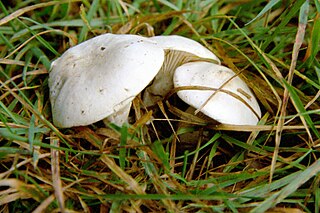
Clitopilus prunulus, commonly known as the miller or the sweetbread mushroom, is an edible pink-spored basidiomycete mushroom found in grasslands in Europe and North America. Growing solitary to gregarious in open areas of conifer/hardwood forests; common under Bishop pine along the coast north of San Francisco; fruiting shortly after the fall rains. It has a grey to white cap and decurrent gills.

Chorioactis is a genus of fungi that contains the single species Chorioactis geaster. The mushroom is commonly known as the devil's cigar or the Texas star in the United States, while in Japan it is called kirinomitake (キリノミタケ). This extremely rare mushroom is notable for its unusual appearance and disjunct distribution; it is found only in select locales in Texas and Japan. The fruit body, which grows on the stumps or dead roots of cedar elms or dead oaks, somewhat resembles a dark brown or black cigar before it splits open radially into a starlike arrangement of four to seven leathery rays. The interior surface of the fruit body bears the spore-bearing tissue known as the hymenium, and is colored white to brown, depending on its age. The fruit body opening can be accompanied by a distinct hissing sound and the release of a smoky cloud of spores.
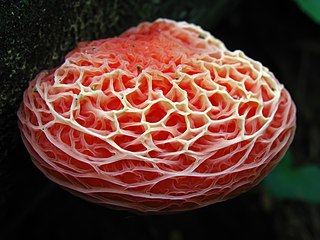
Rhodotus is a genus in the fungus family Physalacriaceae. It is a monotypic genus and consists of the single mushroom species Rhodotus palmatus, known in the vernacular as the netted rhodotus, the rosy veincap, or the wrinkled peach. This uncommon species has a circumboreal distribution, and has been collected in eastern North America, northern Africa, Europe, and Asia; declining populations in Europe have led to its appearance in over half of the European fungal Red Lists of threatened species. Typically found growing on the stumps and logs of rotting hardwoods, mature specimens may usually be identified by the pinkish color and the distinctive ridged and veined surface of their rubbery caps; variations in the color and quantity of light received during development lead to variations in the size, shape, and cap color of fruit bodies.
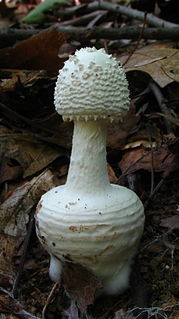
Amanita abrupta, commonly known as the American abrupt-bulbed lepidella, is a species of fungus in the family Amanitaceae. Named for the characteristic shape of its fruit bodies, this white Amanita has a slender stem, a cap covered with conical white warts, and an "abruptly enlarged" swollen base. This terrestrial species grows in mixed woods in eastern North America and eastern Asia, where it is thought to exist in a mycorrhizal relationship with a variety of both coniferous and deciduous tree species.

Entoloma austroprunicolor is a species of agaric fungus in the family Entolomataceae. Described as new to science in 2007, it is found in Tasmania, where it fruits on the ground of wet sclerophyll forests in late spring to early winter. The fruit bodies (mushrooms) have reddish-purple caps measuring up to 5 cm (2.0 in) in diameter supported by whitish stipes measuring 3–7.5 cm (1.2–3.0 in) long by 0.2–0.6 cm (0.1–0.2 in) thick. On the cap underside, the crowded gills are initially white before turning pink as the spores mature.
Psilocybe makarorae is a species of psilocybin mushroom in the family Strophariaceae. Officially described as new to science in 1995, it is known only from New Zealand, where it grows on rotting wood and twigs of southern beeches. The fruit body (mushroom) has a brownish cap with lighter coloured margins, measuring up to 3.5 cm (1.4 in) wide. The cap shape is either conical, bell-shaped, or flat depending on the age of the mushroom, and it features a prominent umbo. Although the whitish stem does not form a true ring, it retains remnants of the partial veil that covers and protects the gills of young fruit bodies. P. makarorae mushrooms can be distinguished from the similar North American species Psilocybe caerulipes by microscopic characteristics such as the presence of cystidia on the gill faces (pleurocystidia), and cheilocystidia with more elongated necks. Based on the bluing reaction to injury, P. makarorae is presumed to contain the psychedelic compounds psilocybin and psilocin.

Spongiforma thailandica is a species of fungus in the family Boletaceae, genus Spongiforma. The stemless sponge-like species, first described in 2009, was found in Khao Yai National Park in central Thailand, where it grows in soil in old-growth forests. The rubbery fruit body, which has a strong odor of coal-tar similar to Tricholoma sulphureum, consists of numerous internal cavities lined with spore-producing tissue. Phylogenetic analysis suggests the species is closely related to the Boletaceae genera Porphyrellus and Strobilomyces.
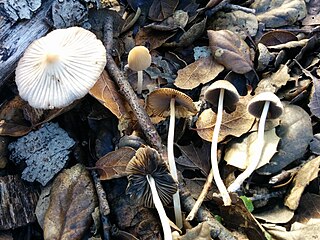
Coprinellus impatiens is a species of fungus in the family Psathyrellaceae. First described in 1821, it has been classified variously in the genera Psathyrella, Pseudocoprinus, Coprinarius, and Coprinus, before molecular phylogenetics reaffirmed it as a Coprinellus species in 2001. The fungus is found in North America and Europe, where the mushrooms grow on the ground in deciduous forests. The fruit bodies have buff caps that are up to 4 cm (1.6 in) in diameter, held by slender whitish stems that can be up to 10 cm (3.9 in) tall. Several other Coprinopsis species that resemble C. impatiens may be distinguished by differences in appearance, habit, or spore morphology.
Clitopilus byssisedoides is a species of fungus in the family Entolomataceae. It was formally described as new to science in 2010, based on specimens found growing in a greenhouse in Botanischer Garten Jena, in Germany.

Entoloma haastii is a mushroom in the Entolomataceae family. Described as new to science in 1964, it is known only from New Zealand, where it grows on the ground in leaf litter, usually near Nothofagus species.

Tuber oregonense, commonly known as the Oregon white truffle, is a species of edible truffle in the genus Tuber. Described as new to science in 2010, the North American species is found on the western coast of the United States, from northern California to southern British Columbia west of the Cascade Range. A mycorrhizal fungus, it grows in a symbiotic association with Douglas fir. It overlaps in distribution with the closely related T. gibbosum, but they have different growing seasons: T. oregonense typically appears from October through March, while T. gibbosum grows from January to June. The fruit bodies of the fungus are roughly spherical to irregular in shape, and resemble small potatoes up to 5 cm (2 in) in diameter. Inside the truffle is the gleba, which is initially white before it becomes a marbled tan color. The large, often thick-walled, and strongly ornamented spores are produced in large spherical asci. The truffle is highly prized for its taste and aroma. Some individuals have claimed success in cultivating the truffles in Christmas tree farms.
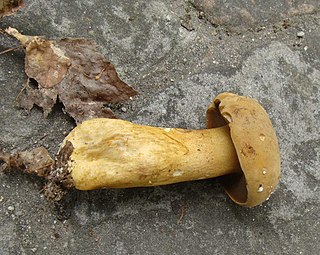
Tylopilus tabacinus is a species of bolete fungus in the family Boletaceae. It is characterized by a tawny-brown cap measuring up to 17.5 cm (6.9 in) in diameter, and a reticulated stem up to 16.5 cm (6.5 in) long by 6 cm (2.4 in) thick. A characteristic microscopic feature is the distinctive crystalline substance encrusted on the hyphae in the surface of the cap. The species is known from the eastern United States from Florida north to Rhode Island, and west to Mississippi, and from eastern Mexico. It is a mycorrhizal species, and associates with oak and beech trees.

Kalapuya brunnea is a species of truffle in the monotypic fungal genus Kalapuya. The truffle occurs only in the Pacific Northwest region of the United States, in western Oregon and northern California. Known locally as the Oregon brown truffle, it was formerly thought to be an undescribed species of Leucangium until molecular analysis demonstrated that it was distinct from that genus. The truffle is reddish brown with a rough and warty outer skin, while the interior spore-producing gleba is initially whitish before developing greyish-brown mottling as it matures. Mature truffles have an odor resembling garlicky cheese, similar to mature Camembert. The species has been harvested for culinary purposes in Oregon.
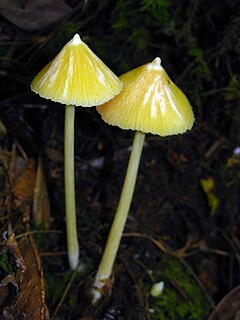
Entoloma murrayi, commonly known as the yellow unicorn Entoloma or the unicorn pinkgill, is a species of fungus in the Entolomataceae family. First described from New England (USA) in 1859, the species is found in eastern North America, Central and South America, and southeast Asia, where it grows on the ground in wet coniferous and deciduous forests. The fungus produces yellow mushrooms that have a characteristic sharp umbo on the top of a conical cap. The mushroom is inedible and may be poisonous. Other similar species can be distinguished from E. murrayi by differences in color, morphology, or microscopic characteristics.

Harrya chromapes, commonly known as the yellowfoot bolete or the chrome-footed bolete, is a species of bolete fungus in the family Boletaceae. The bolete is found in eastern North America, Costa Rica, and eastern Asia, where it grows on the ground, in a mycorrhizal association with deciduous and coniferous trees. Fruit bodies have smooth, rose-pink caps that are initially convex before flattening out. The pores on the cap undersurface are white, aging to a pale pink as the spores mature. The thick stipe has fine pink or reddish dots (scabers), and is white to pinkish but with a bright yellow base. The mushrooms are edible but are popular with insects, and so they are often infested with maggots.

Rhodophana is a genus of mushroom-forming fungi in the family Entolomataceae. It originally described as a genus in 1947 by Robert Kühner, but the description was invalid until it was re-published in 1971, though as a subgenus of Rhodocybe. It did not find favour as a genus until Rhodocybe was found to be polyphyletic and Kluting et al. resurrected the name in 2014 as part of a DNA-based reclassification of the family.

















